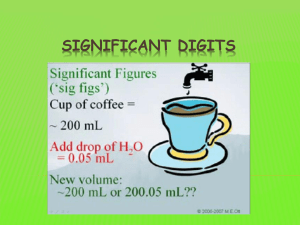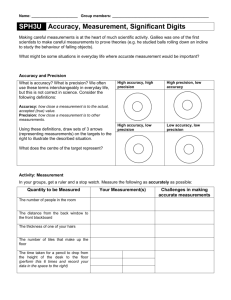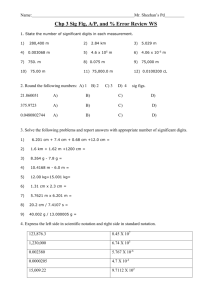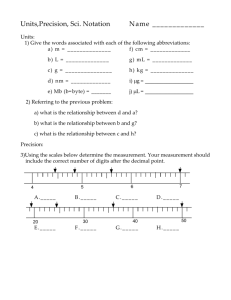Using the Calculator in a Lab Setting
advertisement
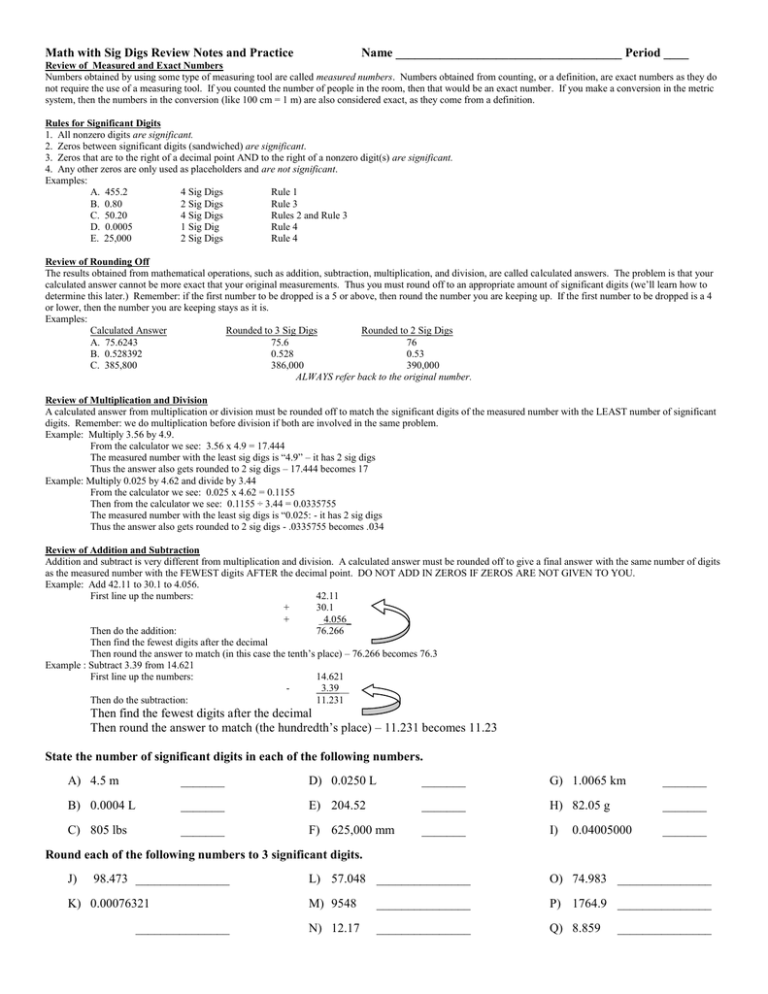
Math with Sig Digs Review Notes and Practice Name ____________________________________ Period ____ Review of Measured and Exact Numbers Numbers obtained by using some type of measuring tool are called measured numbers. Numbers obtained from counting, or a definition, are exact numbers as they do not require the use of a measuring tool. If you counted the number of people in the room, then that would be an exact number. If you make a conversion in the metric system, then the numbers in the conversion (like 100 cm = 1 m) are also considered exact, as they come from a definition. Rules for Significant Digits 1. All nonzero digits are significant. 2. Zeros between significant digits (sandwiched) are significant. 3. Zeros that are to the right of a decimal point AND to the right of a nonzero digit(s) are significant. 4. Any other zeros are only used as placeholders and are not significant. Examples: A. 455.2 4 Sig Digs Rule 1 B. 0.80 2 Sig Digs Rule 3 C. 50.20 4 Sig Digs Rules 2 and Rule 3 D. 0.0005 1 Sig Dig Rule 4 E. 25,000 2 Sig Digs Rule 4 Review of Rounding Off The results obtained from mathematical operations, such as addition, subtraction, multiplication, and division, are called calculated answers. The problem is that your calculated answer cannot be more exact that your original measurements. Thus you must round off to an appropriate amount of significant digits (we’ll learn how to determine this later.) Remember: if the first number to be dropped is a 5 or above, then round the number you are keeping up. If the first number to be dropped is a 4 or lower, then the number you are keeping stays as it is. Examples: Calculated Answer Rounded to 3 Sig Digs Rounded to 2 Sig Digs A. 75.6243 75.6 76 B. 0.528392 0.528 0.53 C. 385,800 386,000 390,000 ALWAYS refer back to the original number. Review of Multiplication and Division A calculated answer from multiplication or division must be rounded off to match the significant digits of the measured number with the LEAST number of significant digits. Remember: we do multiplication before division if both are involved in the same problem. Example: Multiply 3.56 by 4.9. From the calculator we see: 3.56 x 4.9 = 17.444 The measured number with the least sig digs is “4.9” – it has 2 sig digs Thus the answer also gets rounded to 2 sig digs – 17.444 becomes 17 Example: Multiply 0.025 by 4.62 and divide by 3.44 From the calculator we see: 0.025 x 4.62 = 0.1155 Then from the calculator we see: 0.1155 ÷ 3.44 = 0.0335755 The measured number with the least sig digs is “0.025: - it has 2 sig digs Thus the answer also gets rounded to 2 sig digs - .0335755 becomes .034 Review of Addition and Subtraction Addition and subtract is very different from multiplication and division. A calculated answer must be rounded off to give a final answer with the same number of digits as the measured number with the FEWEST digits AFTER the decimal point. DO NOT ADD IN ZEROS IF ZEROS ARE NOT GIVEN TO YOU. Example: Add 42.11 to 30.1 to 4.056. First line up the numbers: 42.11 + 30.1 + _4.056_ Then do the addition: 76.266 Then find the fewest digits after the decimal Then round the answer to match (in this case the tenth’s place) – 76.266 becomes 76.3 Example : Subtract 3.39 from 14.621 First line up the numbers: 14.621 3.39__ Then do the subtraction: 11.231 Then find the fewest digits after the decimal Then round the answer to match (the hundredth’s place) – 11.231 becomes 11.23 State the number of significant digits in each of the following numbers. A) 4.5 m _______ D) 0.0250 L _______ G) 1.0065 km _______ B) 0.0004 L _______ E) 204.52 _______ H) 82.05 g _______ C) 805 lbs _______ F) 625,000 mm _______ I) _______ 0.04005000 Round each of the following numbers to 3 significant digits. J) 98.473 _______________ K) 0.00076321 _______________ L) 57.048 _______________ O) 74.983 _______________ M) 9548 _______________ P) 1764.9 _______________ N) 12.17 _______________ Q) 8.859 _______________ Round each of the following numbers to 2 significant digits. R) 98.473 _______________ V) 12.17 S) 0.00076321 W) 74.983 _______________ _______________ _______________ T) 57.048 _______________ X) 1764.9 _______________ U) 9548 Y) 8.859 _______________ _______________ Perform the following calculations. Give your final answer with the correct amount of Sig Digs. Z) 4.5 x 0.28 _____________________ AA) 0.1184 x 8.0 x 0.034 _____________________ BB) 11.4 ÷ 2.3 _____________________ CC) (42.4 x 5.6) ÷ 1.5 _____________________ DD) (35.56 x 1.45) ÷ (4.8 x 0.56) _____________________ EE) 6.25 g + 0.683 g _____________________ FF) 13.45 mL + 6.5 mL + 0.4552 mL _____________________ GG) 145.5 m + 86.58 m + 1045 m _____________________ HH) 245.625 kg – 80.2 kg _____________________ II) 4.62 cm – 0.885 cm _____________________ State the number of significant digits in each of the following: JJ) 48 cm _____ NN) 71.60 g _____ KK) 306.2 g _____ OO) 0.00432 mm _____ LL) _____ PP) _____ _____ QQ) 82.000 g 0.329 m MM) 83.952 °C 10.0 kg _____ Complete each of the following calculations, expressing the answer with the correct number of significant digits and label. To not have the correct label will lose you points! RR) 3.482 cm + 8.51 cm +16.324 cm _______________ SS) 48.0032 g + 9.17 g + 65.4321 g _______________ TT) 80.4 cm - 16.532 cm _______________ UU) 106.5 mL - 30. mL _______________ VV) 48.2 cm × 1.6 cm × 2.12 cm _______________ WW) 8.3 m × 4.0 m × 0.9823 m _______________ XX) 64.34 cm3 ÷ 8.149 cm _______________ YY) 4.93 mm2 ÷ 18.71 mm _______________ ZZ) 0.057 mL × 760 mm Hg ÷ 740 mm Hg × 273 K ÷ 250 K _______________ AAA) 51.3 g × 44.962 amu ÷ 115.874 amu _______________ BBB) 5 cm + 0.03 cm + 2.0 cm ______________ CCC) 23.27 cm - 12.058 cm ______________ DDD) 350.0 g - 200 g ______________
